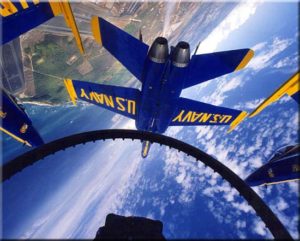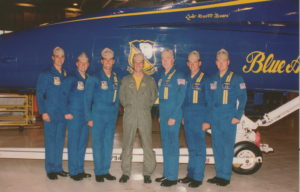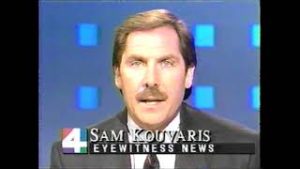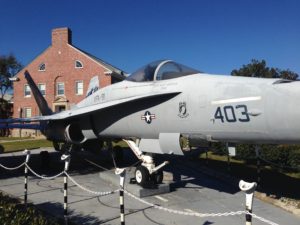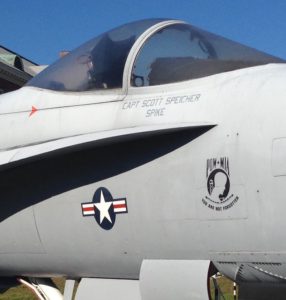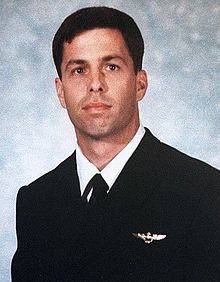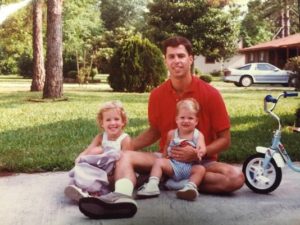A Day at the Beach
Yes, flying high performance aircraft off a ship was fun. Well, maybe not like the goofy grin you have on an amusement park roller coaster when you roar past the camera that captures it. It’s a different kind of fun; exhilarating after the fact, challenging, rewarding. My memories are vivid, but in 17 years of active military flying, one day stands out.
In my career I knew many Blue Angel demo pilots. The Blues are superb aviators and great guys; all of us looked up to them. It’s a demanding job; from January till November they are first training then on the air show circuit, away from their home of Pensacola most of that time, and flying intense practice and demo flights 5-6 times a week. When they aren’t flying they are in the gym (more on that later) or at a social “commit” to meet show-site heavies or visit a hospital, etc. For ten months a year they must be “on” and their performance is scrutinized daily.
LCDR Mark “Gucci” Dunleavy was a Wildcat squadron mate, and in 1998 he was Blue Angel #4, flying the slot in the trademark Delta formation in his second season. The Boss was CDR George “Elwood” Dom, a contemporary and friend. Earlier that year Gucci invited me to fly with the team. It is that easy to fly with the Blue Angels.
We selected July 9, 1998 as a demo practice I could join. This was not just any practice. It was practice for the annual Pensacola Beach show, and would be conducted the Friday before the Saturday show. The “Beach Show” is Pensacola’s biggest event and attendance is well into six figures. We would take off from NAS Pensacola, fly the ten or so miles to the beach, fly a 40 minute demo, and recover back at the air station. Cool.
As a squadron Executive Officer everyone is nice to you, and my request to fly a Hornet to Pensacola was approved. Those of you familiar with the forested monotony of I-10 from Jacksonville to Pensacola will appreciate the 45 minute flight in an FA-18. (Once flying from Pensacola to Jacksonville I accomplished it in 38 minutes. You could do it in under 30, but only once.)
I landed at Pensacola’s Sherman Field and taxied up to the Blue Angel flight line. A razor-sharp crewman in blue coveralls and Ray-Ban shades directed me in to my parking spot with crisp signals. With a smile he said not to worry about the jet, he’d button it up.
Gucci welcomed me and we departed for Perdido Key to stow his ski boat. The team had spent the day waterskiing with finalists “rushing” the team in a last opportunity to get to know them before selection. One of them we had served with was Tater, who we would meet later at Pensacola Beach.
At the Sandshaker we ordered Bushwackers and caught up with all the aviators in familiar fashion, filling the air with jargon and acronyms. There I caught up with Tater and Elwood, and met the others on the team whom I had not met. We had a fun night on beautiful Pensacola Beach, with the finest sugar-white sand in the world. Tater was excited at the prospect of joining the team, and was envious of me flying with them the next day.
The team invited me to sit in on their preflight brief, an honor I appreciated. From a checklist Elwood went over the maneuvers, and in a way that allowed the pilots to envision themselves flying it. The Blue Angel flight brief is likened to a séance, and I spied pilots with eyes closed moving their hands as if they were flying as Elwood described each sequence. Think about it; this is halfway through the season of flying demos almost daily, they’ve got it, but they still cover each maneuver in detail. Frankly, it is a hallmark of tactical aviation, but nonetheless I was impressed with the level of detail and concentration in this “routine” Blue Angel flight brief.
I walked to the jet early to get myself situated in the back seat of the two-seater Gucci would fly for this practice. In the paraloft I was asked if I wanted to wear my G-suit. There is only one answer when flying with the team – no.
The Blue Angels do not wear G-suits, which can add an extra 2-3 g’s of g tolerance. They can interfere with their flight control; going 350 knots only 18 inches from another jet requires fine adjustments. They are also cumbersome to put on and off and don’t look cool on a blue flight suit. The pilots spend hours in the gym most days; they are world class athletes who can crank on 6 g’s for 40 minutes, then step out of the jet looking fresh as a flower.
With me already strapped the team marched down the line and each pilot peeled off to his jet as they would in front of a crowd. On signal Gucci started us up and in no time all six jets were ready for taxi. I got the aft cockpit energized and the jets taxied in formation to the hold short line. Like the pilots, I was fitted with a boom mic, leaving my oxygen mask behind.
We took position on Runway 25 and got the weather report; thunderstorms to the northwest. We could see them, but Elwood decided we had enough time before they arrived. His wingmen each acknowledged his radio calls in rapid fashion. They were pumped up, excited, ready to fly a perfect demo. In my experience, us pilots on radio check-ins try to sound too cool for school, just another day at the office. But the Blues are almost childlike in their enthusiastic radio comms. It’s concentration, from when they march to the jets to when they salute at the end of the demo, and the radio enthusiasm helps them stayed focused.
We rolled down the runway as a division, four jets maintaining position on Elwood as we gained flying speed. As the Number 2 jet lifted off and raised the landing gear, Gucci, feeding in left rudder while holding his wings level, slid under #2, our nose moving into the position #2’s main mounts occupied as they retracted into the aircraft. Wow.
We turned south and crossed Johnson Beach, heading out to sea. “Wanna fly?” Gucci asked. I said, “Yeah, I’ve got it,” and took control. On occasion fleet aviators fly the diamond formation returning from a hop, and as a senior aviator it had been a while since I flew as #4 in a diamond. I allowed myself a smile; flying form in the Blue Angel Diamond is heady stuff, and soon it was the Delta as Numbers 5 and 6 joined. Elwood led us in a wide arc to the east at 500 feet as I maintained a “fleet” distance on him. Approaching Pensacola Beach, Gucci said, “I’ll take it back now.” We transferred control again, and he then positioned us “Blue Angel close” to #1. I was amazed how close we were; the exhaust nozzles of Elwood’s Hornet were right above my head, and it was loud.
With smoke “on” we thundered over the familiar “beach ball” water tower and the two solos broke off. The beach was packed with people and boats jammed Little Sabine Bay. Skies to the west were graying, and lowering.
With a sing-song cadence over the radio Elwood led the diamond through each maneuver. The radio chatter was heavy as the diamond and the solos hit their check points, the object being to keep jets in front of the crowd to the maximum practicable.
We set up over Fort Pickens for the Double Farvel. Zipping down the beach at under 500 feet – me waving at people on the shoreline – the formation loosened up and on signal Elwood and Gucci rolled inverted, which is a cool way to say upside down. The formation tightened again, and I found myself looking “up” at the bottom of Elwood’s jet with shoreline breakers in the background. Hanging in my straps I waved at the Casino Beach crowd as we rocketed past and once clear of show center opened up, rolled upright, and back into the normal diamond.
The weather continued to come down, with a ledge of overcast that prevented us from conducting iconic overhead maneuvers like the Line Abreast Loop or Delta Break Cross. We continued in the “Flat Show.”
Halfway through the demo the diamond “breaks up” for certain maneuvers allowing the pilots to pull hard and put some g on the jets. I was able to withstand the g, but one time Gucci reefed on a turn to rendezvous on Elwood over Gulf Breeze. Tightening my leg and abdominal muscles I was ready for it, and felt my vision gray and then tunnel – not unfamiliar sensations for tactical aviators – before finally going black. I was awake with eyes open, but could not see. Gucci let off the g and my vision returned at once.
Along for the ride, watching a Blue Angel demo from inside it, I caught myself smiling that goofy roller coaster smile. While fun, I was impressed with everything. The level of precision and commitment to excellence were an order above what I had experienced in my naval aviation career, and that’s saying something.
The weather was about to hit Sherman Field, and Elwood had to get us home. With a final Delta Flat Pass to wave good-bye, we headed west to Fort Pickens where Elwood detached us in order. Each pilot slowed in trail, dropping their gear and flaps for landing on Runway 36. We rolled to the end and into a sheet of rain, rain that followed us back to the flight line. After scampering through the deluge to the hangar – not cool! – we took a “six-man” photo as the thunderstorm beat up NAS Pensacola.
They invited me to the debrief, another honor. Every military flight ends with a debrief and receiving frank, constructive criticism is a daily occurrence for aviators, but the Blues take it to a higher level. Constructive criticism was delivered among the teammates and in no uncertain terms; even Elwood received his share. While fleet Commanding Officers are debriefed by juniors on their flight performance, I was taken aback. There was no sugar coating, and each pilot raised his hand and admitted a shortcoming on that flight that they would fix. Another friend who served on the team said you must put on your big-boy pants and take it. These transgressions were transparent to me, but they detected them in themselves and each other and did not ignore them.
Once the debrief ended I showed them the newest fleet gizmo, the Anvis-9 Night Vision Goggles, which they took turns with as the ready room lights were extinguished. With smiles and handshakes they then bade me farewell…it was after 5pm on a Friday with the big show Saturday but they remained behind to pick the new demo pilots for the 1999 team.
The maintenance crew was all there, and despite their friendly smiles I knew why – me! I quickly filed my flight plan and started up. My plan was to wait till sunset to rendezvous with an Air Force KC-135 tanker over the Atlantic that my squadron arranged for night in-flight refueling practice. I saluted good-bye and taxied to the hold-short line where I sat at idle power for 45 minutes as the sun lowered. Timing it, I took off early and conserved fuel over north Florida enroute to the tanker off Jacksonville, as planned.
Driving home I reflected on the experience. What an unforgettable day, amid friends, with can-do professionals delivering a precision performance, exhilarating and fun. Everyone was terrific and could not have been nicer. Each Blue Angel I’ve ever known, from pilot to support crew, is friendly and personable, with self-deprecating humor and humble appreciation to be part of the team. Simply put, the Blue Angels are good, and know how to have fun.
When They Call Your Baby Ugly
On occasion my wife and I will find ourselves in a sidewalk art gallery in a sunny park or outlet mall plaza strolling past booth after booth of paintings, sculptures, photographs, and carvings. People can make things out of almost anything, and while we browse – and sometimes actually break down and buy something – we can marvel at human talent and abilities we do not possess. The works are awe-inspiring. As children all of us knew we could draw, and we proudly showed our works to anyone who would stop long enough to look. Children receive praise for scribbling, and that praise encourages them to keep at it and get better. Then adolescence happens, and at the other end of that almost none of us can draw or think that we have a shred of talent for art. We become our toughest hyper-critics…and in dark moments can turn green with envy.
I’m guilty of it. A major league baseball player can line a base hit – it is an incredible accomplishment just to be able to step into a major league batter’s box – and then be picked off base. “What an idiot!” I’ll cry at the TV as the runner trots back to the dugout with his head down. Now, I never was a major leaguer – never played little league! But as a fan I know a base running mistake when I see one, and as a fan I can boo the player from the safety of my living room or safety of the stands. It’s expected, and players take it from fans who are not qualified to carry their bat bag, etc.
One thing I would never do, even if a stadium usher escorted me to the dugout and then introduced me to the player, is to then call him an idiot to his face. He’s an accomplished professional and here I am in my dad jeans with mustard on my shirt. I might say, gosh, tough break out there, but was that a curveball you lined to left? Wow, great to meet you. May I please have your autograph, for my son, of course?
We’re safe in the stands, and safe behind the wheel when a less talented driver than we are does something less talented than we would. Yeah, we let them have it, you idiot! knowing deep down that we would be mortified to say something to their faces. Most of us anyway…about 98% of the population by my reckoning.
Which brings us to the internet.
It’s easy to rate things on the internet. I’ve always wondered why five stars is the standard from which to deviate. Why not six, or ten; don’t we like to rank things from one to ten? Regardless, five stars is what we rate restaurants, hotels, and products from grass trimmers to software – and books.
Authors, who in some respects are the kids who pushed through the internal and external attacks of adolescence and take a chance to produce something, knowing that someone is going to reject it, crave reviews of their work. On one hand we want to get better, but deeper down I believe it is natural for an author – artist – to ask a reader or viewer what they think. Did we get it right? Did we connect with you?
Reviews – good reviews – help to sell anything. They are social proof that something is good – or “other.” We give greater weight to a review by a total stranger than one from anyone close to us; Jesus talks about his aspect of human nature in the Bible.
Peter Reed – a reader from Australia whom I do not know – wrote the first review for Raven One. It was four stars, and instead of thanking him I asked (in the comments) what would it take to earn five. That was a mistake and my publisher quickly corrected me. Just accept it, taking the good with the bad (or vice versa). (Thank you, Peter, glad you enjoyed it.)
Sometimes reviewers are effuse with praise – and give four stars. Other times a terse “good read” comment is accompanied by five stars. Sometimes reviewers are upset with the E-reader software and give one star with no comments about the quality, good or other, of the story. For the most part, however, readers that are motivated to review are kind and encouraging, even where they see shortfalls. Comparing the numbers of reviews to numbers of units sold/downloaded, I’ve found that about 2-3% of my readers take the time to leave a review.
Reviewers on Amazon and Goodreads are, for the most part, amateur book reviewers. That said, they are readers and customers, and their comments influence the buying decisions of others…and we are not even talking about how Amazon bots treat reviews and put products in front of potential buyers. As a writer, and maybe a writer with my background, I respect the trends gleaned from reviews. If a sidewalk art show artist heard a passerby say that he or she thought there were too many brush strokes used in a painting or they preferred oil to acrylic or watercolor, I think the artist would just smile and ignore them. When I receive similar constructive criticism about placement and numbers of words, I’ll listen. The scouting report on me? Too technical. That said, readers appear to love the authenticity and realism my story immersion provides, and stay with my epics till the end. As writer I must cater to my audience in the techno-thriller genre. Sure, I welcome all readers and for less than five bucks one can take a chance and try something new. My job then and always is to keep the reader turning the pages to see what happens next. (After Raven One, I cracked the jargon back about a quarter turn.)
Should a writer (service provider? manufacturer?) respond to reviewers? As a writer, I believe no. Maybe I should, but being human it would be a challenge to thank a reviewer who just threw a flaming one-star javelin into my computer screen. I do appreciate all reviews submitted; I’ll just say thank you here or if you contact me. However , there are exceptions when the reviews are especially kind and poignant, or when they are exceptionally cruel and personal and have their facts wrong. The internet has a way of bringing out the worst in us; 99% of the time we writers should just ignore it and drive on. Me personally? My book reviewer average is pretty much 4.99 stars, but I was always a Santa!
Thank you, readers and reviewers. Your reviews encourage and refine; all businesses and organizations crave feedback and for this writer it is no different. That said, I’ll keep writing the books I want to write, offering them for you to read and to comment on their quality, focus on the positive, and stay true to myself.
Patriot Games
WJXT Sports Director Sam Kouvaris has been a fixture in the Jacksonville sports scene for over 35 years. With Tom and Deb, and George with the weather, Sam and the Channel 4 anchor team were familiar and friendly faces at 6 and 11pm. Pre-ESPN sports junkie viewers like myself enjoyed Sam’s commentary on the sports news of the day. More than just reading scores, he gave insight and even meaning to the “human drama of athletic competition.” With nearby Daytona, Sawgrass, and Gainesville and Tallahassee in their football heydays, Sam was conversant in everything sports and well connected.
In late 1992 naval aviation in general and carrier aviation in particular was reeling. The Tailhook scandal raged, and senior aviators played rope-a-dope, waiting for the media, political, and even intra-service pummeling to pass. It was also during this time that the resurgent Dallas Cowboys were marching to the Super Bowl, and the “America’s Team” hype was back. We at Cecil Field were America’s Team, but how to convey that? Movies like TOPGUN and shows like Supercarrier didn’t help matters, and my neighbors in Jacksonville would see a Hornet high overhead but have no idea how they were flown or why. So I opened the yellow pages and got the address for WJXT, then wrote a letter, in longhand, to Sam Kouvaris and invited him to go on a training hop with us. Then I mailed it, with a postage stamp. Two weeks later he called.
We chatted about doing a story on my squadron, the VFA-131 Wildcats, and how we trained. Sam was a bagger from way back; flying with the Blue Angels is something media personalities around the country do on a weekly basis, but bagging a carrier landing off the coast with my friend Brillo at the controls of a two-seat Hornet is more than most reporters get. Sam said sure, if you can swing it, I’m game. He played it cool…inside he must have been thinking are you kidding me! Hell yeah I want to go on a training hop!
So, prepared to ask forgiveness as I did throughout my career, I pitched it to my CO, Hawk. My vision was an air wing practice strike; Hornets and Vikings from Cecil, Tomcats, E-2’s and A-6’s from Norfolk, Marine EA-6B jammers from Cherry Point, all refueled by Air Force KC-10’s from North Carolina. We’d have the 125th Fighter Wing from Jacksonville, flying F-16s at the time, oppose us as we would fight our way into Pinecastle, bomb it, and then fight our way back out. And, ah, oh yeah, Skipper…I invited Sam Kouvaris to ride along. Yes, sir, the reporter.
Hawk was all for it, and I got to work coordinating it, again with good old fashioned phone calls, paper and pen. Time on target; 30 April 1993.
Sam got his medical and seat check updated, and in the months running up to it I mailed letters explaining what we were doing – deep background – and described a typical training hop that we flew daily to the local practice targets or over the ocean as pre-game warm up drills. The practice strike was likened to a college spring game football scrimmage, and training and learning never ended. Sam and his cameraman Kevin, who has been with him for three decades, came out to Cecil and we showed them around the squadron and put them in the simulator. They spoke to the sailors – the pit crew – and many of them were on the broadcast, with Senior Chief Murchison and Chief Langham featured. They asked questions about flying. I think it was Kevin who asked me if it was possible to fly under the Main Street Bridge or some such thing. I replied that you can do anything once. Sam tells me that quote lives on in the TV-4 newsroom.
Beaner took the reins of the Wildcats and together we brought this project to the Wing Commodore, Spock. Now early 1993, Navy was dealing with the increased budget pressures of a new administration to the already Draconian “peace dividend,” plus the distraction of the “gays in the military” issue which became Don’t Ask, Don’t Tell. The Tailhook fallout continued. In this high-threat battle space everyone was gun-shy, and my project had a low positive benefit and a very high negative if it went south.
Spock liked it, but was concerned about a civilian in the middle of a practice strike formation, regardless of the risk-management measures we applied to it. I would lead a two-plane “section” to the Pinecastle target complex with Sam flying with a VFA-106 instructor. After I bombed and strafed, we’d go out to the area and meet up with a Topcat S-3 for tanking practice. So it is written, so it shall be done.
On 29 April Burner and I, with Sam in Burner’s trunk and armed with an 8mm camera, took off for Pinecastle. I’m not sure if formation dive deliveries are done anymore, (guess I could find out!) but in the video Burner is flying formation on me as we overbank and pull down to the target. Sam is not used to this, and must hold the camera on me; once my bomb comes off you can sense him fighting the sudden g force as Burner follows me on the pull off. The strafing clip is excellent, with Burner stabilized right there. That’s the sound of my 20mm cannon on the video, unedited, coming through the Plexiglas canopy from 300 feet away – cool!
Everyone loves their jargon, and Sam stopped me once after I referred to “filming.” We don’t film, we tape, get it right! So we flew over Daytona and over the Atlantic where I demo-ed in-flight refueling as Sam taped with Burner flying form. After some intercepts we flew over the city and into the break at Cecil. That afternoon, Air Wing Seven squadrons arrived from Norfolk, as did the Marine Prowlers.
April 30, 1993 was a severe clear day in Jacksonville – one less variable! – and we briefed this gorilla. It had 8 of us Wildcats and 8 Gunstars from our sister squadron. Two divisions of Dakota and Dog F-14’s and four Blue Blaster A-6’s, plus E-2s from the Bluetails, and the Marine EA-6Bs. Roles were assigned and fuel was allocated, as were take off and target times. The guys that helped me plan it flew it; you’ll see my roommate Bullet (who remains on active duty, and yes, we called him Bullet then) who was alternate lead, with Comet, who later became the Commodore, Box, Tails, Gucci, Possum, Smack and Bags. There’s Biff, of whom Rick Reilly told his Sports Illustrated readers to run from, and Durt who survived a night in the gulf and took it all in stride. Smurf, and Leo – what a great guy Leo was. Air Wing Seven’s call sign was Freedom, as it is today.
Walking to the jet I was pumped, and Bullet slapped me on the back; “Freedom freakin’ Lead!” The size of the strike didn’t really hit me until on the taxiway and seeing all the Toms and Intruders – uncommon to Cecil – taxi into position. Game time.
We joined on the KC-10’s off Savannah, got our gas, and then pushed south. Every mile and minute is structured, but you must be ready for what-if pop-ups. You, listen, monitor, decide, and talk only when required. The Vipers intercepted us and the sweep Tomcats and Hornets dealt with them. About 16 of us pressed down to Pinecastle, going feet-dry over Ormond Beach and rolled in from a high dive, a tactic passed down from our ancestors.
We flew back out the way we came, then knocked it off. Sam and Kevin met me at the flight line and I didn’t spike the ball, acting as if we’d been in the end-zone before. You know, the image-is-everything routine. He prompted me to show some emotion, c’mon, man! Guess I needed Crash Davis to coach me up on post-game media interviews.
They then got to work editing, and decided to call it Patriot Games, after a recent title of another best-selling techno-thriller from a remarkable new novelist.
Two weeks later Channel 4 aired the story over two nights, in reverse order of how the events occurred. Lites, then the Gunstar Commanding Officer and no stranger to squadron press coverage, laughed as he bowed down to me in mock supplication; you win, you win!
Bullet soon departed for Pentagon shore duty, and months later told me he had seen the clip in a Public Affairs briefing of what Navy needed more of.
Sam, with Kevin alongside, serves ably at Channel 4, delivering a first class broadcast night after night in a town he loves and where he raised his fine family. The local P-3 and Seahawk guys got with the program, and Sam has flown with them too. He is a loyal advocate of naval aviation, and cites his experiences with us as the highlight of his career. Check out his unforgettable Rampager Change of Command speech sometime.
He said people would often ask him if he was a pilot, and he was tired of saying no. He did something about it, and today is an instrument and multi-engine rated general aviation pilot. Me, I just write about flying.
Hope you all enjoy watching Patriot Games, which was taped 25 years ago this week.
Flying With Spike
Next to the academic building at Naval Aviation Schools Command in Pensacola is a F/A-18 Hornet painted in the livery of Strike-Fighter Squadron 81, the Sunliners. All who begin their naval aviation adventure begin it in Pensacola, and this building and the jet parked next to it are familiar landmarks. There is a name painted under the canopy, a high honor for such an iconic static display aircraft, one that is viewed by hundreds each month as they take the first steps in the long journey to wings. The name is a challenge to them, a name carefully chosen of one to emulate. Be like this name, the stenciling suggests.
CAPT SCOTT SPEICHER
It is doubtful that any of today’s students were alive when this name was in the news over 27 years ago, but certainly some are aware of this man and his actions in combat. To Americans of a certain age – a nice way of saying much older – this name may jog a memory. Where have I heard that name before?
To me, and many readers of this blog, the callsign under the stenciling conveys warm feelings of friendship and shared good times, of loyal devotion to duty, of trust, and courage. And an infectious smile.
SPIKE
I first met Spike in 1986 at Cecil Field when, due to hangar overcrowding, our A-7 squadrons were shoe-horned together for a period of time. Spike was in VA-105, a squadron that years later would hold special meaning for me. What a great group the Gunslingers had; Shoe, Mongo, Duck, Lady, Bone, Bud-Man, Frailes, Roots. We had fun hanging out in the cramped ready room, and it was evident all the guys had high regard for Spike.
Spike was a year or two senior to me, and before I could become a shore-duty instructor in the F/A-18 I had to first learn the jet. Spike was one of my instructors in the Gladiators. My logbook records that our first “flight” together was March, 12, 1988, each of us in a Hornet conducting 1v1 Basic Fighter Maneuvering training over the Atlantic. I do not have a memory of this hop, but later that month my class went to Fallon for Air-to-Ground training and Spike was one of the instructors. It was on this det we got to know each other better as squadronmates. I’m sure he led formations I was part of, and I probably bought him a beer or two at the Silver State O-Club as penance for small in-flight infractions
With the airline good-life beckoning, junior aviators were resigning from the Navy as fast as they could. Back at Cecil the JO’s were herded into the ready room for a meeting with the Wing Commodore. Like any good leader he wanted to know what was on our minds and what could be done to keep us in uniform. He got an earful, and, exasperated, he asked, “Is anyone going to stay in?” In a room with Frailes who would one day command a carrier and wear stars, with Irish who rose to CAG, with Kid who 15 years later commanded the Gladiators, and others like me who stayed for careers, only one lieutenant ignored the peer pressure and raised his hand: Scott Speicher.
That August I was hanging around the ready room and Spike had an open back seat for a Fighter Weps hop he was instructing. I asked to jump in and he said sure. The set up was Spike leading a student in another Hornet against two A-4 “bandits.” I’m sure we had an enjoyable chat over the cockpit ICS as we led the student out to sea south of Ponte Vedra. However, once over the Atlantic it was all business. With a 40 mile split both formations came at each other as the Hornets worked their radars and communicated what they were seeing to each other on the radio. This is intense, fast, difficult, and at the merge damn dangerous. It is fun to be sure, but professional reputations are on the line and all of it will be debriefed in detail. Spike had to fly our jet and in a sense that of the student he was instructing. All I had to do was observe and keep a lookout. I think it was on this hop we were coming down the back side of a loop – we were inverted! – about 16,000 feet and a single red party balloon floated by our left wing, both of us incredulous that it was “out here” at least 30 miles east of St. Augustine.
The following is a vivid memory.
We were egressing west after an engagement, unloading for airspeed and with our wingman in sight. I saw an A-4 about two miles at our three-o’clock going to four and nose-off. I keyed the ICS.
“Tally one A-4 three-o’clock, two miles!” As soon as the words came out of my mouth I regretted them.
Spike snapped the jet right and into the “threat.” At once he saw the Skyhawk was no factor and yanked it back to the left to resume. “That guy’s no threat!” he scolded me with an edge and made it clear that future bad calls from me were not appreciated. Spike was easygoing and relaxed, but in this environment he was a fierce competitor first, even in this canned training scenario.
A minute later all was forgiven and forgotten, replaced with the exhilaration of flying a Hornet and enjoying Florida’s First Coast float under us on the way home. He led us into the break and let me fly a landing from the backseat. What a great time. They were all great times.
Though Spike was taller and better built, we resembled each other. One day as he picked up his daughter at the Orange Park preschool, my 2-year-old toddled over to him with outstretched arms thinking it was time to go. Another time I was summoned for a fitness report debrief. The skipper placed the paper in front of me and I read it. After I finished I said, “Skipper, this is a great fitness report. Unfortunately for me I’m not Scott Speicher.” He said something like “Doh!” and gave me my fitrep, which was more like what I was expecting.
Needling is part of squadron life. With my brother arriving at the airport in three hours, I led a division gun hop. In a hurry, I left the power up and “cruised” the formation at .93 Mach all the way out to the area off Amelia Island with Spike and the others hanging on. We shot the bullets, joined up, and hauled for home, also at .93. Spike laughed at me in the debrief as the lead of the shortest air-to-air gun hop he’d ever flown. I met my brother on time.
Spike left for his department head tour in VFA-81, and I saw him shortly before Saratoga deployed. He was genuine, and when he said let’s get together after the cruise, he meant it. In August of 1990 our world changed, and in the ensuing months many of my friends deployed to the Red Sea and Arabian Gulf. My ship didn’t go…I watched Desert Storm on TV…but steeled myself for losses. We didn’t know what to expect from a combat-experienced Iraqi Air Force in a new and unproven environment.
We received a call the Spike was missing, and that morning SECDEF himself declared him KIA. We were stunned. Not Spike. A month later we were stunned again. Not BJ.
The years rolled on, and rumors surfaced that things did not happen the way we were told that night. Spike ejected, we found out, with evidence he was alive on the ground.
Twelve years later Baghdad fell. Then at the Pentagon, I was told that finding Saddam was job one, with finding Spike a close #2.
Spike didn’t come home, and his story has been told and will be told better in time, but Spike was a shipmate in the truest sense of the word. An uncompromising warrior, those of us who knew him knew him as a devoted husband and father, a devout Christian who lived his faith, a superstar athlete, a model officer and superb aviator, a fun guy to be around…a great guy. There are a lot of great guys out there, but he really was.
Yes, the years roll on. It doesn’t happen often anymore, but being of a certain age there are occasions I am asked if I knew Spike. Yes, I smile, and tell them that he was one of the greatest guys I ever served with.
